Literature Review of Climate Change and its Economic Implications
VerifiedAdded on 2023/04/22
|12
|3638
|457
AI Summary
This document provides a literature review of climate change and its economic implications. It discusses the relationship between climate change and economics, analyzing the statistical methods used in previous studies. The document also explores the solutions proposed to mitigate the impact of climate change. The subject is Introduction to Researching in Business Economics, and the course code is MS40045E.
Contribute Materials
Your contribution can guide someone’s learning journey. Share your
documents today.
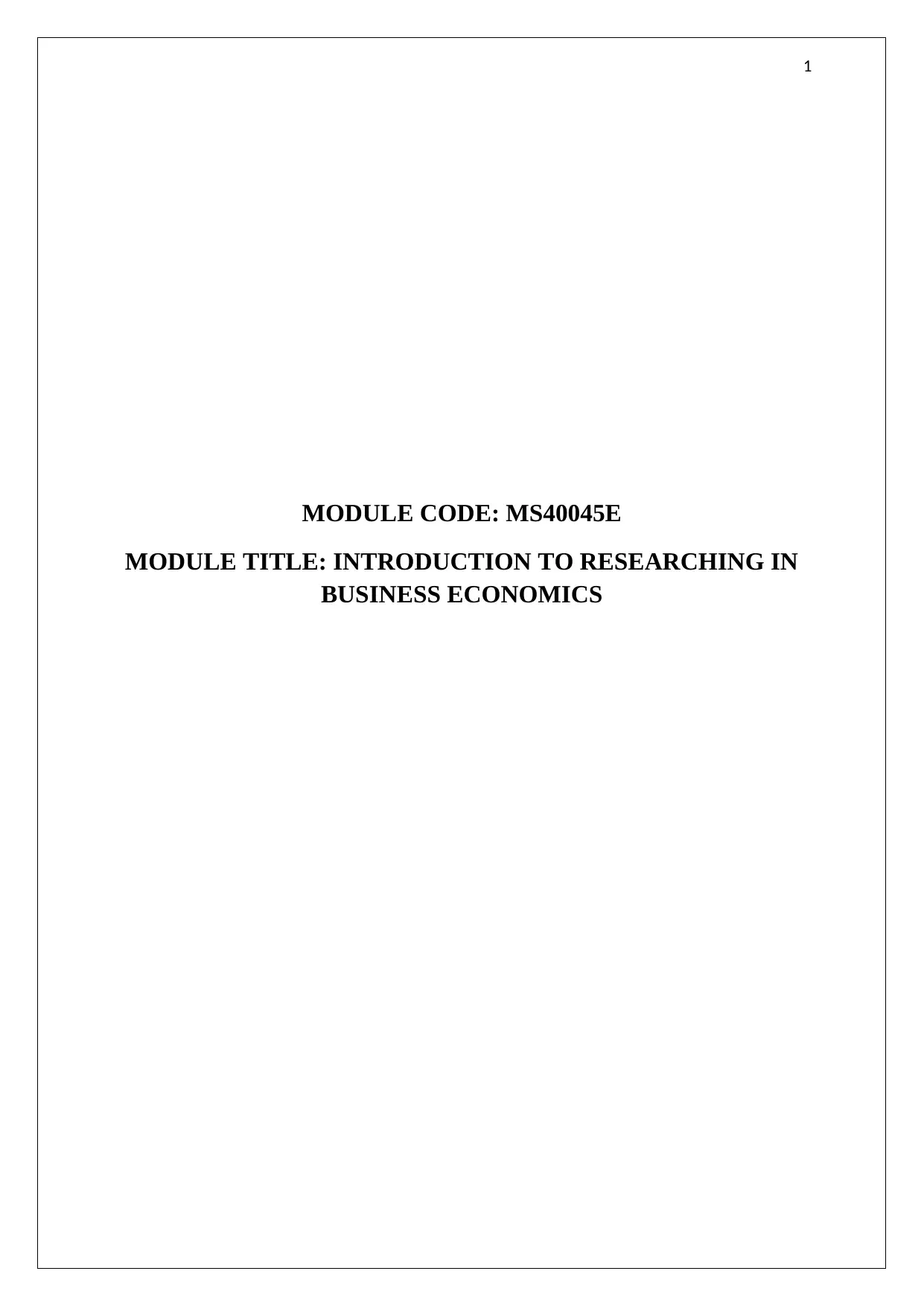
1
MODULE CODE: MS40045E
MODULE TITLE: INTRODUCTION TO RESEARCHING IN
BUSINESS ECONOMICS
MODULE CODE: MS40045E
MODULE TITLE: INTRODUCTION TO RESEARCHING IN
BUSINESS ECONOMICS
Secure Best Marks with AI Grader
Need help grading? Try our AI Grader for instant feedback on your assignments.
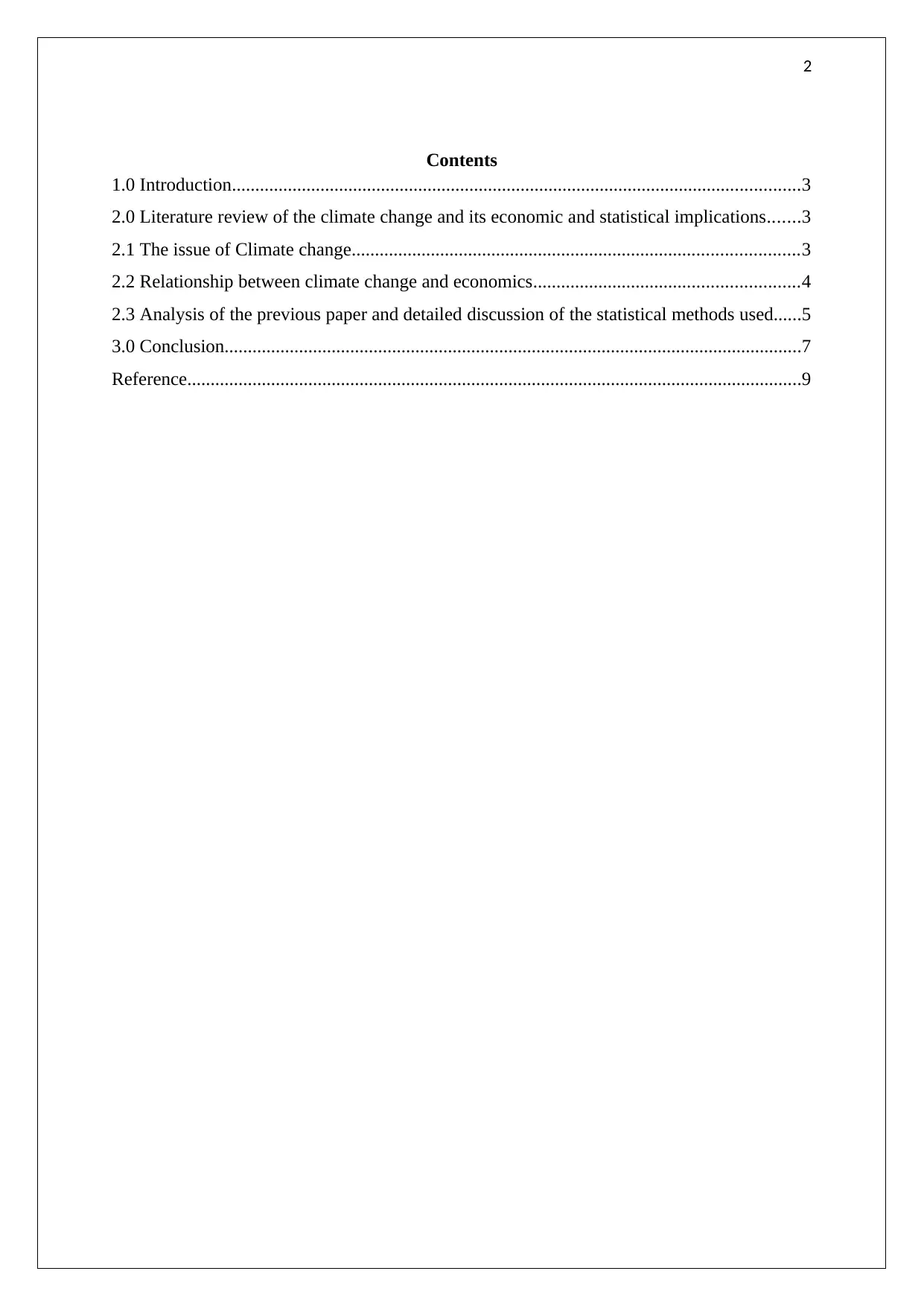
2
Contents
1.0 Introduction..........................................................................................................................3
2.0 Literature review of the climate change and its economic and statistical implications.......3
2.1 The issue of Climate change................................................................................................3
2.2 Relationship between climate change and economics.........................................................4
2.3 Analysis of the previous paper and detailed discussion of the statistical methods used......5
3.0 Conclusion............................................................................................................................7
Reference....................................................................................................................................9
Contents
1.0 Introduction..........................................................................................................................3
2.0 Literature review of the climate change and its economic and statistical implications.......3
2.1 The issue of Climate change................................................................................................3
2.2 Relationship between climate change and economics.........................................................4
2.3 Analysis of the previous paper and detailed discussion of the statistical methods used......5
3.0 Conclusion............................................................................................................................7
Reference....................................................................................................................................9
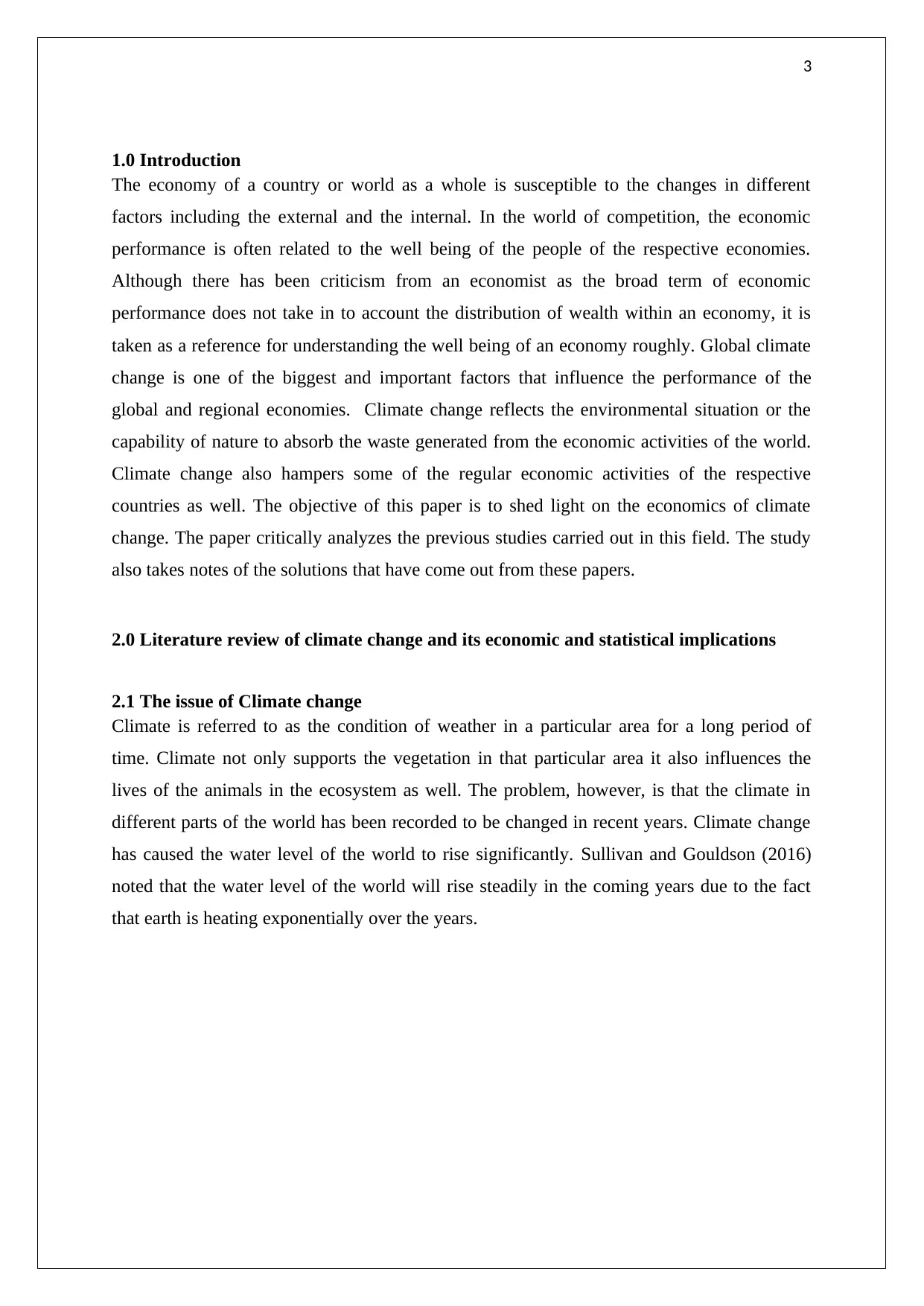
3
1.0 Introduction
The economy of a country or world as a whole is susceptible to the changes in different
factors including the external and the internal. In the world of competition, the economic
performance is often related to the well being of the people of the respective economies.
Although there has been criticism from an economist as the broad term of economic
performance does not take in to account the distribution of wealth within an economy, it is
taken as a reference for understanding the well being of an economy roughly. Global climate
change is one of the biggest and important factors that influence the performance of the
global and regional economies. Climate change reflects the environmental situation or the
capability of nature to absorb the waste generated from the economic activities of the world.
Climate change also hampers some of the regular economic activities of the respective
countries as well. The objective of this paper is to shed light on the economics of climate
change. The paper critically analyzes the previous studies carried out in this field. The study
also takes notes of the solutions that have come out from these papers.
2.0 Literature review of climate change and its economic and statistical implications
2.1 The issue of Climate change
Climate is referred to as the condition of weather in a particular area for a long period of
time. Climate not only supports the vegetation in that particular area it also influences the
lives of the animals in the ecosystem as well. The problem, however, is that the climate in
different parts of the world has been recorded to be changed in recent years. Climate change
has caused the water level of the world to rise significantly. Sullivan and Gouldson (2016)
noted that the water level of the world will rise steadily in the coming years due to the fact
that earth is heating exponentially over the years.
1.0 Introduction
The economy of a country or world as a whole is susceptible to the changes in different
factors including the external and the internal. In the world of competition, the economic
performance is often related to the well being of the people of the respective economies.
Although there has been criticism from an economist as the broad term of economic
performance does not take in to account the distribution of wealth within an economy, it is
taken as a reference for understanding the well being of an economy roughly. Global climate
change is one of the biggest and important factors that influence the performance of the
global and regional economies. Climate change reflects the environmental situation or the
capability of nature to absorb the waste generated from the economic activities of the world.
Climate change also hampers some of the regular economic activities of the respective
countries as well. The objective of this paper is to shed light on the economics of climate
change. The paper critically analyzes the previous studies carried out in this field. The study
also takes notes of the solutions that have come out from these papers.
2.0 Literature review of climate change and its economic and statistical implications
2.1 The issue of Climate change
Climate is referred to as the condition of weather in a particular area for a long period of
time. Climate not only supports the vegetation in that particular area it also influences the
lives of the animals in the ecosystem as well. The problem, however, is that the climate in
different parts of the world has been recorded to be changed in recent years. Climate change
has caused the water level of the world to rise significantly. Sullivan and Gouldson (2016)
noted that the water level of the world will rise steadily in the coming years due to the fact
that earth is heating exponentially over the years.
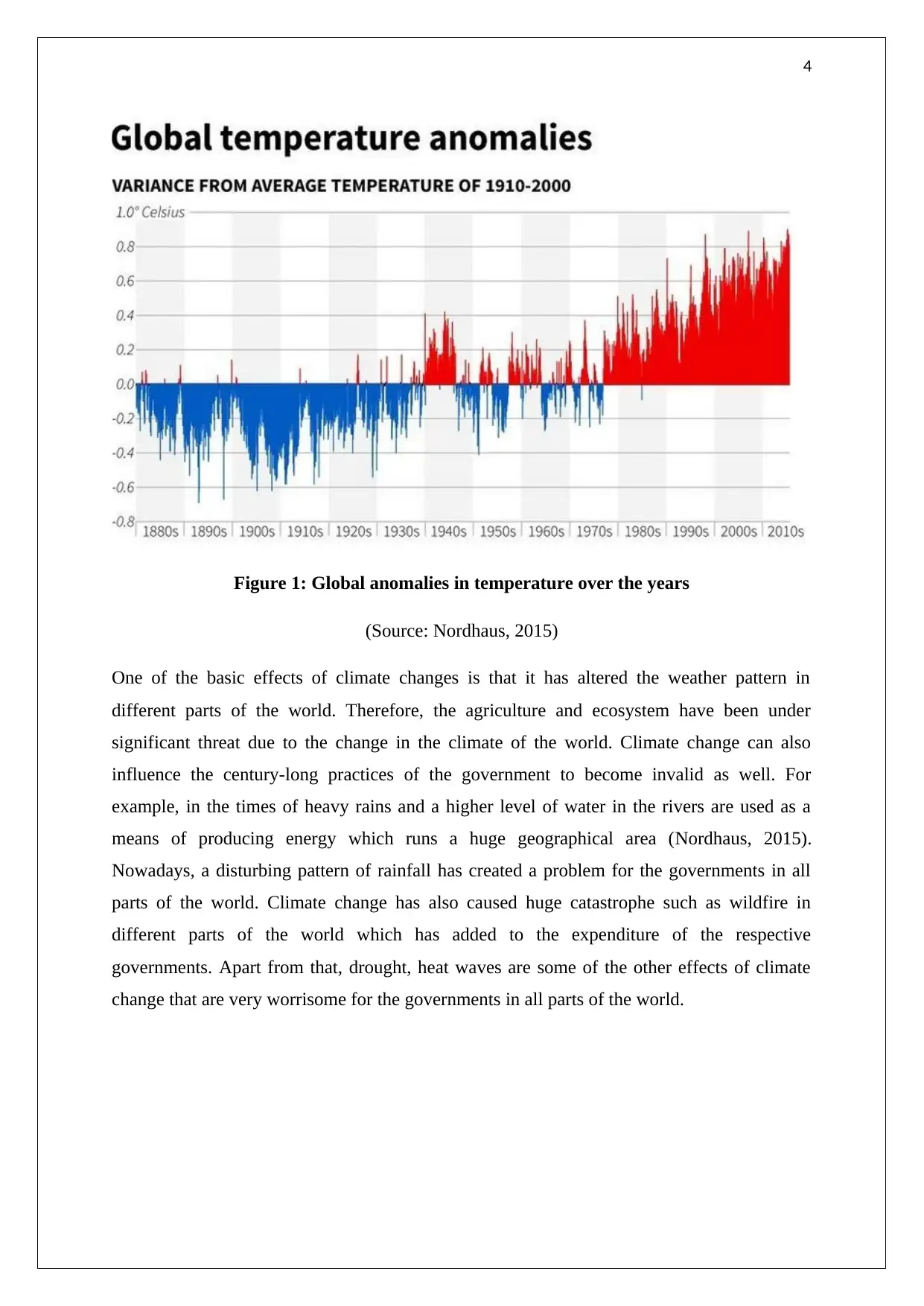
4
Figure 1: Global anomalies in temperature over the years
(Source: Nordhaus, 2015)
One of the basic effects of climate changes is that it has altered the weather pattern in
different parts of the world. Therefore, the agriculture and ecosystem have been under
significant threat due to the change in the climate of the world. Climate change can also
influence the century-long practices of the government to become invalid as well. For
example, in the times of heavy rains and a higher level of water in the rivers are used as a
means of producing energy which runs a huge geographical area (Nordhaus, 2015).
Nowadays, a disturbing pattern of rainfall has created a problem for the governments in all
parts of the world. Climate change has also caused huge catastrophe such as wildfire in
different parts of the world which has added to the expenditure of the respective
governments. Apart from that, drought, heat waves are some of the other effects of climate
change that are very worrisome for the governments in all parts of the world.
Figure 1: Global anomalies in temperature over the years
(Source: Nordhaus, 2015)
One of the basic effects of climate changes is that it has altered the weather pattern in
different parts of the world. Therefore, the agriculture and ecosystem have been under
significant threat due to the change in the climate of the world. Climate change can also
influence the century-long practices of the government to become invalid as well. For
example, in the times of heavy rains and a higher level of water in the rivers are used as a
means of producing energy which runs a huge geographical area (Nordhaus, 2015).
Nowadays, a disturbing pattern of rainfall has created a problem for the governments in all
parts of the world. Climate change has also caused huge catastrophe such as wildfire in
different parts of the world which has added to the expenditure of the respective
governments. Apart from that, drought, heat waves are some of the other effects of climate
change that are very worrisome for the governments in all parts of the world.
Secure Best Marks with AI Grader
Need help grading? Try our AI Grader for instant feedback on your assignments.
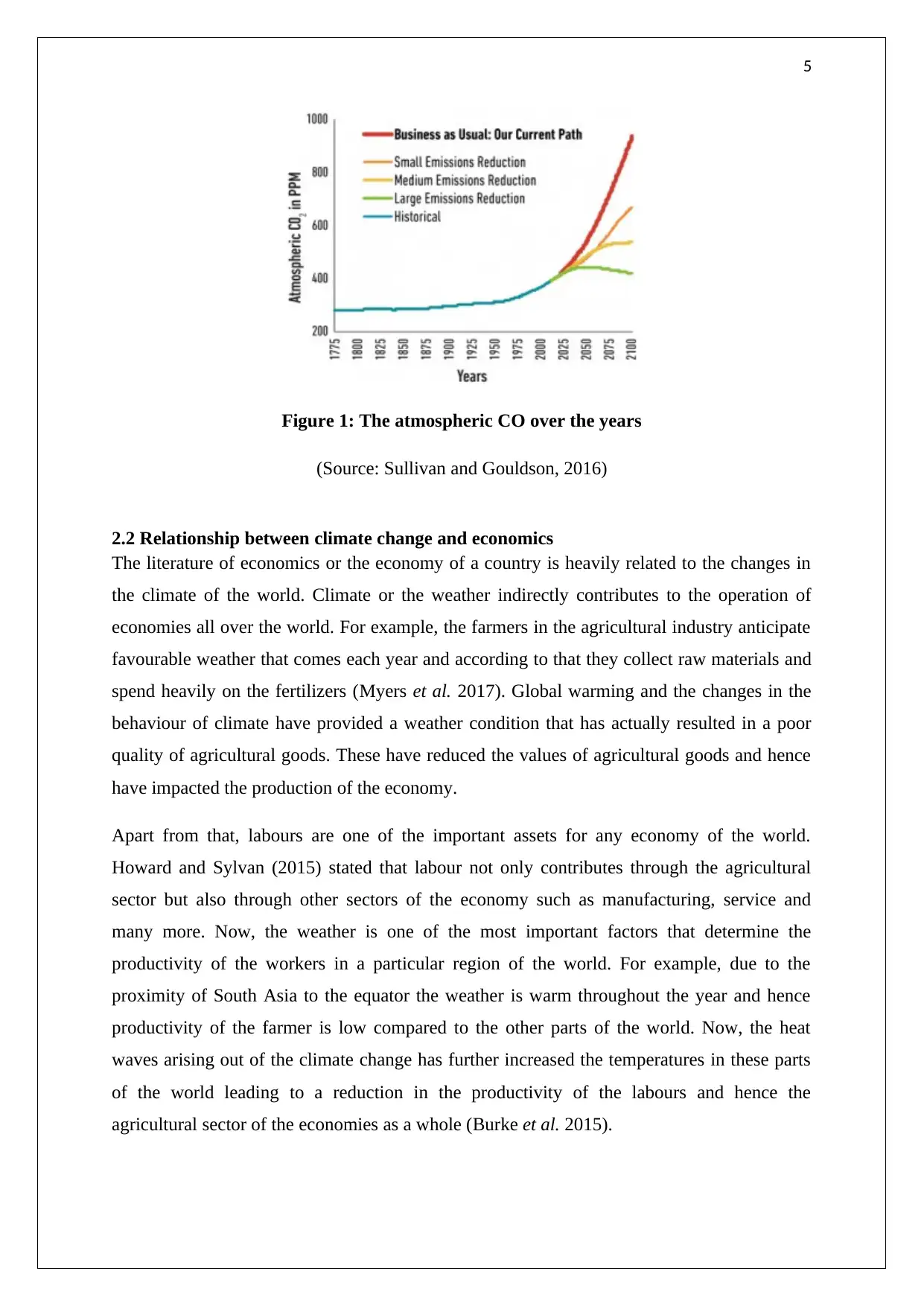
5
Figure 1: The atmospheric CO over the years
(Source: Sullivan and Gouldson, 2016)
2.2 Relationship between climate change and economics
The literature of economics or the economy of a country is heavily related to the changes in
the climate of the world. Climate or the weather indirectly contributes to the operation of
economies all over the world. For example, the farmers in the agricultural industry anticipate
favourable weather that comes each year and according to that they collect raw materials and
spend heavily on the fertilizers (Myers et al. 2017). Global warming and the changes in the
behaviour of climate have provided a weather condition that has actually resulted in a poor
quality of agricultural goods. These have reduced the values of agricultural goods and hence
have impacted the production of the economy.
Apart from that, labours are one of the important assets for any economy of the world.
Howard and Sylvan (2015) stated that labour not only contributes through the agricultural
sector but also through other sectors of the economy such as manufacturing, service and
many more. Now, the weather is one of the most important factors that determine the
productivity of the workers in a particular region of the world. For example, due to the
proximity of South Asia to the equator the weather is warm throughout the year and hence
productivity of the farmer is low compared to the other parts of the world. Now, the heat
waves arising out of the climate change has further increased the temperatures in these parts
of the world leading to a reduction in the productivity of the labours and hence the
agricultural sector of the economies as a whole (Burke et al. 2015).
Figure 1: The atmospheric CO over the years
(Source: Sullivan and Gouldson, 2016)
2.2 Relationship between climate change and economics
The literature of economics or the economy of a country is heavily related to the changes in
the climate of the world. Climate or the weather indirectly contributes to the operation of
economies all over the world. For example, the farmers in the agricultural industry anticipate
favourable weather that comes each year and according to that they collect raw materials and
spend heavily on the fertilizers (Myers et al. 2017). Global warming and the changes in the
behaviour of climate have provided a weather condition that has actually resulted in a poor
quality of agricultural goods. These have reduced the values of agricultural goods and hence
have impacted the production of the economy.
Apart from that, labours are one of the important assets for any economy of the world.
Howard and Sylvan (2015) stated that labour not only contributes through the agricultural
sector but also through other sectors of the economy such as manufacturing, service and
many more. Now, the weather is one of the most important factors that determine the
productivity of the workers in a particular region of the world. For example, due to the
proximity of South Asia to the equator the weather is warm throughout the year and hence
productivity of the farmer is low compared to the other parts of the world. Now, the heat
waves arising out of the climate change has further increased the temperatures in these parts
of the world leading to a reduction in the productivity of the labours and hence the
agricultural sector of the economies as a whole (Burke et al. 2015).
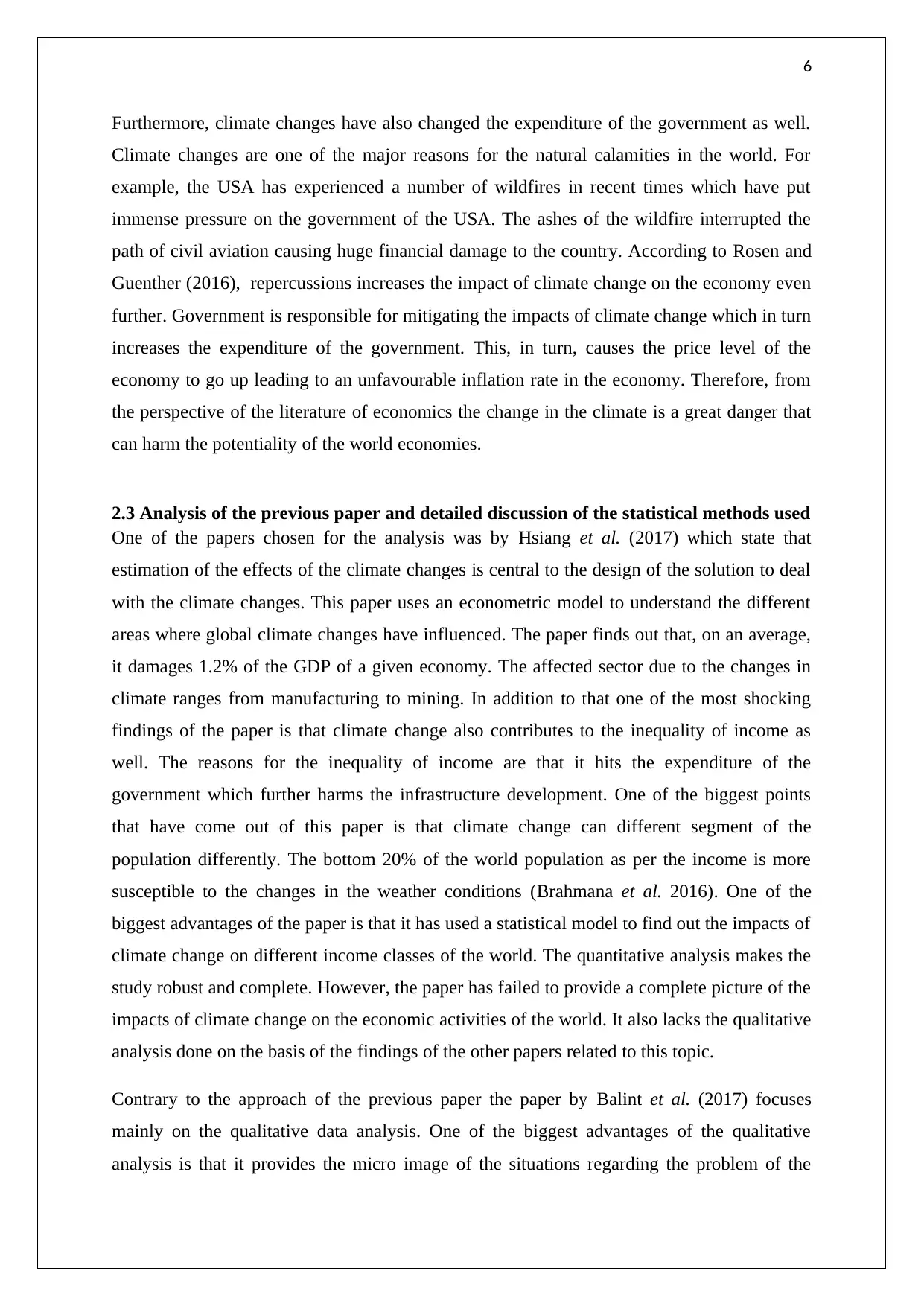
6
Furthermore, climate changes have also changed the expenditure of the government as well.
Climate changes are one of the major reasons for the natural calamities in the world. For
example, the USA has experienced a number of wildfires in recent times which have put
immense pressure on the government of the USA. The ashes of the wildfire interrupted the
path of civil aviation causing huge financial damage to the country. According to Rosen and
Guenther (2016), repercussions increases the impact of climate change on the economy even
further. Government is responsible for mitigating the impacts of climate change which in turn
increases the expenditure of the government. This, in turn, causes the price level of the
economy to go up leading to an unfavourable inflation rate in the economy. Therefore, from
the perspective of the literature of economics the change in the climate is a great danger that
can harm the potentiality of the world economies.
2.3 Analysis of the previous paper and detailed discussion of the statistical methods used
One of the papers chosen for the analysis was by Hsiang et al. (2017) which state that
estimation of the effects of the climate changes is central to the design of the solution to deal
with the climate changes. This paper uses an econometric model to understand the different
areas where global climate changes have influenced. The paper finds out that, on an average,
it damages 1.2% of the GDP of a given economy. The affected sector due to the changes in
climate ranges from manufacturing to mining. In addition to that one of the most shocking
findings of the paper is that climate change also contributes to the inequality of income as
well. The reasons for the inequality of income are that it hits the expenditure of the
government which further harms the infrastructure development. One of the biggest points
that have come out of this paper is that climate change can different segment of the
population differently. The bottom 20% of the world population as per the income is more
susceptible to the changes in the weather conditions (Brahmana et al. 2016). One of the
biggest advantages of the paper is that it has used a statistical model to find out the impacts of
climate change on different income classes of the world. The quantitative analysis makes the
study robust and complete. However, the paper has failed to provide a complete picture of the
impacts of climate change on the economic activities of the world. It also lacks the qualitative
analysis done on the basis of the findings of the other papers related to this topic.
Contrary to the approach of the previous paper the paper by Balint et al. (2017) focuses
mainly on the qualitative data analysis. One of the biggest advantages of the qualitative
analysis is that it provides the micro image of the situations regarding the problem of the
Furthermore, climate changes have also changed the expenditure of the government as well.
Climate changes are one of the major reasons for the natural calamities in the world. For
example, the USA has experienced a number of wildfires in recent times which have put
immense pressure on the government of the USA. The ashes of the wildfire interrupted the
path of civil aviation causing huge financial damage to the country. According to Rosen and
Guenther (2016), repercussions increases the impact of climate change on the economy even
further. Government is responsible for mitigating the impacts of climate change which in turn
increases the expenditure of the government. This, in turn, causes the price level of the
economy to go up leading to an unfavourable inflation rate in the economy. Therefore, from
the perspective of the literature of economics the change in the climate is a great danger that
can harm the potentiality of the world economies.
2.3 Analysis of the previous paper and detailed discussion of the statistical methods used
One of the papers chosen for the analysis was by Hsiang et al. (2017) which state that
estimation of the effects of the climate changes is central to the design of the solution to deal
with the climate changes. This paper uses an econometric model to understand the different
areas where global climate changes have influenced. The paper finds out that, on an average,
it damages 1.2% of the GDP of a given economy. The affected sector due to the changes in
climate ranges from manufacturing to mining. In addition to that one of the most shocking
findings of the paper is that climate change also contributes to the inequality of income as
well. The reasons for the inequality of income are that it hits the expenditure of the
government which further harms the infrastructure development. One of the biggest points
that have come out of this paper is that climate change can different segment of the
population differently. The bottom 20% of the world population as per the income is more
susceptible to the changes in the weather conditions (Brahmana et al. 2016). One of the
biggest advantages of the paper is that it has used a statistical model to find out the impacts of
climate change on different income classes of the world. The quantitative analysis makes the
study robust and complete. However, the paper has failed to provide a complete picture of the
impacts of climate change on the economic activities of the world. It also lacks the qualitative
analysis done on the basis of the findings of the other papers related to this topic.
Contrary to the approach of the previous paper the paper by Balint et al. (2017) focuses
mainly on the qualitative data analysis. One of the biggest advantages of the qualitative
analysis is that it provides the micro image of the situations regarding the problem of the
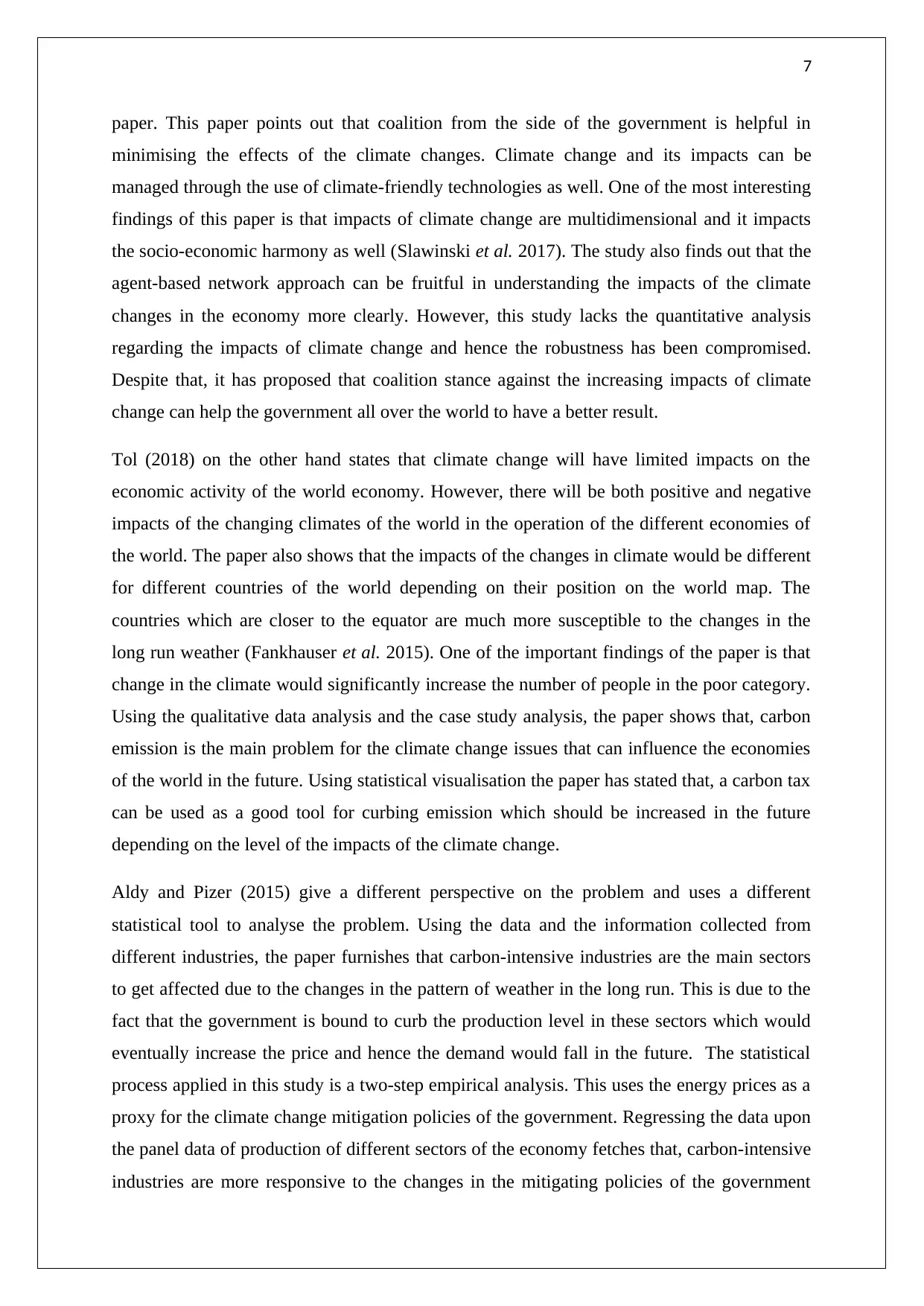
7
paper. This paper points out that coalition from the side of the government is helpful in
minimising the effects of the climate changes. Climate change and its impacts can be
managed through the use of climate-friendly technologies as well. One of the most interesting
findings of this paper is that impacts of climate change are multidimensional and it impacts
the socio-economic harmony as well (Slawinski et al. 2017). The study also finds out that the
agent-based network approach can be fruitful in understanding the impacts of the climate
changes in the economy more clearly. However, this study lacks the quantitative analysis
regarding the impacts of climate change and hence the robustness has been compromised.
Despite that, it has proposed that coalition stance against the increasing impacts of climate
change can help the government all over the world to have a better result.
Tol (2018) on the other hand states that climate change will have limited impacts on the
economic activity of the world economy. However, there will be both positive and negative
impacts of the changing climates of the world in the operation of the different economies of
the world. The paper also shows that the impacts of the changes in climate would be different
for different countries of the world depending on their position on the world map. The
countries which are closer to the equator are much more susceptible to the changes in the
long run weather (Fankhauser et al. 2015). One of the important findings of the paper is that
change in the climate would significantly increase the number of people in the poor category.
Using the qualitative data analysis and the case study analysis, the paper shows that, carbon
emission is the main problem for the climate change issues that can influence the economies
of the world in the future. Using statistical visualisation the paper has stated that, a carbon tax
can be used as a good tool for curbing emission which should be increased in the future
depending on the level of the impacts of the climate change.
Aldy and Pizer (2015) give a different perspective on the problem and uses a different
statistical tool to analyse the problem. Using the data and the information collected from
different industries, the paper furnishes that carbon-intensive industries are the main sectors
to get affected due to the changes in the pattern of weather in the long run. This is due to the
fact that the government is bound to curb the production level in these sectors which would
eventually increase the price and hence the demand would fall in the future. The statistical
process applied in this study is a two-step empirical analysis. This uses the energy prices as a
proxy for the climate change mitigation policies of the government. Regressing the data upon
the panel data of production of different sectors of the economy fetches that, carbon-intensive
industries are more responsive to the changes in the mitigating policies of the government
paper. This paper points out that coalition from the side of the government is helpful in
minimising the effects of the climate changes. Climate change and its impacts can be
managed through the use of climate-friendly technologies as well. One of the most interesting
findings of this paper is that impacts of climate change are multidimensional and it impacts
the socio-economic harmony as well (Slawinski et al. 2017). The study also finds out that the
agent-based network approach can be fruitful in understanding the impacts of the climate
changes in the economy more clearly. However, this study lacks the quantitative analysis
regarding the impacts of climate change and hence the robustness has been compromised.
Despite that, it has proposed that coalition stance against the increasing impacts of climate
change can help the government all over the world to have a better result.
Tol (2018) on the other hand states that climate change will have limited impacts on the
economic activity of the world economy. However, there will be both positive and negative
impacts of the changing climates of the world in the operation of the different economies of
the world. The paper also shows that the impacts of the changes in climate would be different
for different countries of the world depending on their position on the world map. The
countries which are closer to the equator are much more susceptible to the changes in the
long run weather (Fankhauser et al. 2015). One of the important findings of the paper is that
change in the climate would significantly increase the number of people in the poor category.
Using the qualitative data analysis and the case study analysis, the paper shows that, carbon
emission is the main problem for the climate change issues that can influence the economies
of the world in the future. Using statistical visualisation the paper has stated that, a carbon tax
can be used as a good tool for curbing emission which should be increased in the future
depending on the level of the impacts of the climate change.
Aldy and Pizer (2015) give a different perspective on the problem and uses a different
statistical tool to analyse the problem. Using the data and the information collected from
different industries, the paper furnishes that carbon-intensive industries are the main sectors
to get affected due to the changes in the pattern of weather in the long run. This is due to the
fact that the government is bound to curb the production level in these sectors which would
eventually increase the price and hence the demand would fall in the future. The statistical
process applied in this study is a two-step empirical analysis. This uses the energy prices as a
proxy for the climate change mitigation policies of the government. Regressing the data upon
the panel data of production of different sectors of the economy fetches that, carbon-intensive
industries are more responsive to the changes in the mitigating policies of the government
Paraphrase This Document
Need a fresh take? Get an instant paraphrase of this document with our AI Paraphraser
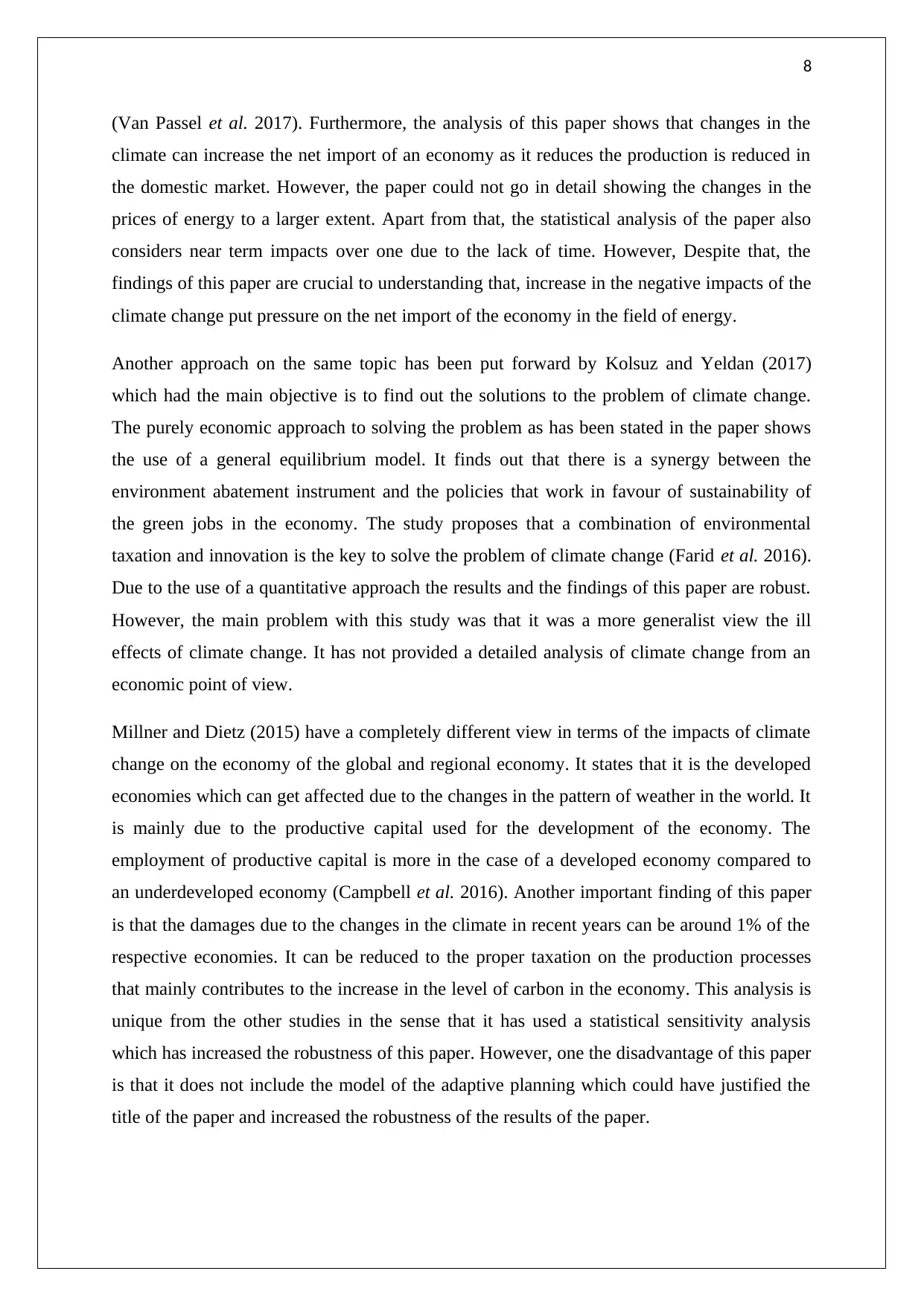
8
(Van Passel et al. 2017). Furthermore, the analysis of this paper shows that changes in the
climate can increase the net import of an economy as it reduces the production is reduced in
the domestic market. However, the paper could not go in detail showing the changes in the
prices of energy to a larger extent. Apart from that, the statistical analysis of the paper also
considers near term impacts over one due to the lack of time. However, Despite that, the
findings of this paper are crucial to understanding that, increase in the negative impacts of the
climate change put pressure on the net import of the economy in the field of energy.
Another approach on the same topic has been put forward by Kolsuz and Yeldan (2017)
which had the main objective is to find out the solutions to the problem of climate change.
The purely economic approach to solving the problem as has been stated in the paper shows
the use of a general equilibrium model. It finds out that there is a synergy between the
environment abatement instrument and the policies that work in favour of sustainability of
the green jobs in the economy. The study proposes that a combination of environmental
taxation and innovation is the key to solve the problem of climate change (Farid et al. 2016).
Due to the use of a quantitative approach the results and the findings of this paper are robust.
However, the main problem with this study was that it was a more generalist view the ill
effects of climate change. It has not provided a detailed analysis of climate change from an
economic point of view.
Millner and Dietz (2015) have a completely different view in terms of the impacts of climate
change on the economy of the global and regional economy. It states that it is the developed
economies which can get affected due to the changes in the pattern of weather in the world. It
is mainly due to the productive capital used for the development of the economy. The
employment of productive capital is more in the case of a developed economy compared to
an underdeveloped economy (Campbell et al. 2016). Another important finding of this paper
is that the damages due to the changes in the climate in recent years can be around 1% of the
respective economies. It can be reduced to the proper taxation on the production processes
that mainly contributes to the increase in the level of carbon in the economy. This analysis is
unique from the other studies in the sense that it has used a statistical sensitivity analysis
which has increased the robustness of this paper. However, one the disadvantage of this paper
is that it does not include the model of the adaptive planning which could have justified the
title of the paper and increased the robustness of the results of the paper.
(Van Passel et al. 2017). Furthermore, the analysis of this paper shows that changes in the
climate can increase the net import of an economy as it reduces the production is reduced in
the domestic market. However, the paper could not go in detail showing the changes in the
prices of energy to a larger extent. Apart from that, the statistical analysis of the paper also
considers near term impacts over one due to the lack of time. However, Despite that, the
findings of this paper are crucial to understanding that, increase in the negative impacts of the
climate change put pressure on the net import of the economy in the field of energy.
Another approach on the same topic has been put forward by Kolsuz and Yeldan (2017)
which had the main objective is to find out the solutions to the problem of climate change.
The purely economic approach to solving the problem as has been stated in the paper shows
the use of a general equilibrium model. It finds out that there is a synergy between the
environment abatement instrument and the policies that work in favour of sustainability of
the green jobs in the economy. The study proposes that a combination of environmental
taxation and innovation is the key to solve the problem of climate change (Farid et al. 2016).
Due to the use of a quantitative approach the results and the findings of this paper are robust.
However, the main problem with this study was that it was a more generalist view the ill
effects of climate change. It has not provided a detailed analysis of climate change from an
economic point of view.
Millner and Dietz (2015) have a completely different view in terms of the impacts of climate
change on the economy of the global and regional economy. It states that it is the developed
economies which can get affected due to the changes in the pattern of weather in the world. It
is mainly due to the productive capital used for the development of the economy. The
employment of productive capital is more in the case of a developed economy compared to
an underdeveloped economy (Campbell et al. 2016). Another important finding of this paper
is that the damages due to the changes in the climate in recent years can be around 1% of the
respective economies. It can be reduced to the proper taxation on the production processes
that mainly contributes to the increase in the level of carbon in the economy. This analysis is
unique from the other studies in the sense that it has used a statistical sensitivity analysis
which has increased the robustness of this paper. However, one the disadvantage of this paper
is that it does not include the model of the adaptive planning which could have justified the
title of the paper and increased the robustness of the results of the paper.
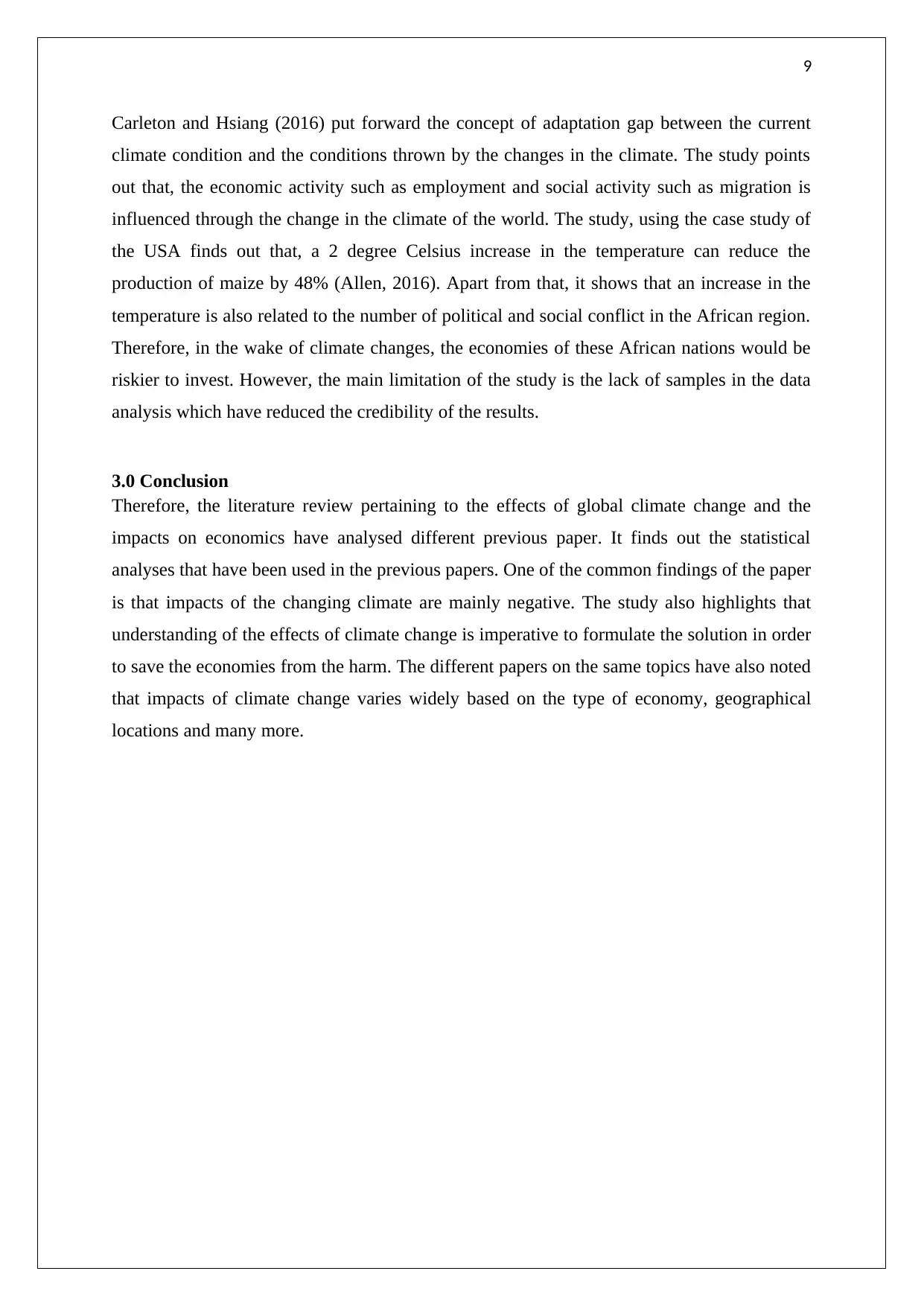
9
Carleton and Hsiang (2016) put forward the concept of adaptation gap between the current
climate condition and the conditions thrown by the changes in the climate. The study points
out that, the economic activity such as employment and social activity such as migration is
influenced through the change in the climate of the world. The study, using the case study of
the USA finds out that, a 2 degree Celsius increase in the temperature can reduce the
production of maize by 48% (Allen, 2016). Apart from that, it shows that an increase in the
temperature is also related to the number of political and social conflict in the African region.
Therefore, in the wake of climate changes, the economies of these African nations would be
riskier to invest. However, the main limitation of the study is the lack of samples in the data
analysis which have reduced the credibility of the results.
3.0 Conclusion
Therefore, the literature review pertaining to the effects of global climate change and the
impacts on economics have analysed different previous paper. It finds out the statistical
analyses that have been used in the previous papers. One of the common findings of the paper
is that impacts of the changing climate are mainly negative. The study also highlights that
understanding of the effects of climate change is imperative to formulate the solution in order
to save the economies from the harm. The different papers on the same topics have also noted
that impacts of climate change varies widely based on the type of economy, geographical
locations and many more.
Carleton and Hsiang (2016) put forward the concept of adaptation gap between the current
climate condition and the conditions thrown by the changes in the climate. The study points
out that, the economic activity such as employment and social activity such as migration is
influenced through the change in the climate of the world. The study, using the case study of
the USA finds out that, a 2 degree Celsius increase in the temperature can reduce the
production of maize by 48% (Allen, 2016). Apart from that, it shows that an increase in the
temperature is also related to the number of political and social conflict in the African region.
Therefore, in the wake of climate changes, the economies of these African nations would be
riskier to invest. However, the main limitation of the study is the lack of samples in the data
analysis which have reduced the credibility of the results.
3.0 Conclusion
Therefore, the literature review pertaining to the effects of global climate change and the
impacts on economics have analysed different previous paper. It finds out the statistical
analyses that have been used in the previous papers. One of the common findings of the paper
is that impacts of the changing climate are mainly negative. The study also highlights that
understanding of the effects of climate change is imperative to formulate the solution in order
to save the economies from the harm. The different papers on the same topics have also noted
that impacts of climate change varies widely based on the type of economy, geographical
locations and many more.
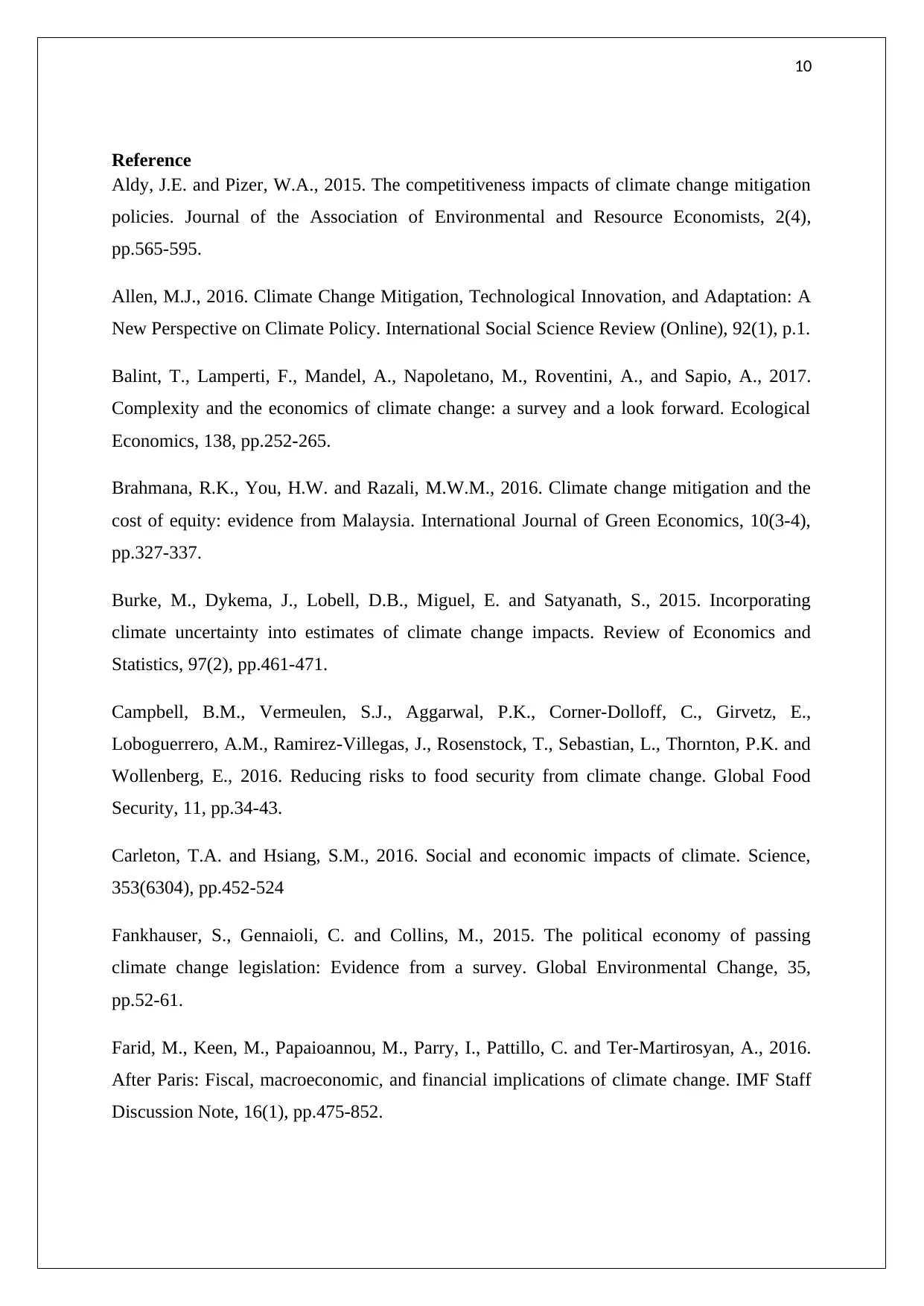
10
Reference
Aldy, J.E. and Pizer, W.A., 2015. The competitiveness impacts of climate change mitigation
policies. Journal of the Association of Environmental and Resource Economists, 2(4),
pp.565-595.
Allen, M.J., 2016. Climate Change Mitigation, Technological Innovation, and Adaptation: A
New Perspective on Climate Policy. International Social Science Review (Online), 92(1), p.1.
Balint, T., Lamperti, F., Mandel, A., Napoletano, M., Roventini, A., and Sapio, A., 2017.
Complexity and the economics of climate change: a survey and a look forward. Ecological
Economics, 138, pp.252-265.
Brahmana, R.K., You, H.W. and Razali, M.W.M., 2016. Climate change mitigation and the
cost of equity: evidence from Malaysia. International Journal of Green Economics, 10(3-4),
pp.327-337.
Burke, M., Dykema, J., Lobell, D.B., Miguel, E. and Satyanath, S., 2015. Incorporating
climate uncertainty into estimates of climate change impacts. Review of Economics and
Statistics, 97(2), pp.461-471.
Campbell, B.M., Vermeulen, S.J., Aggarwal, P.K., Corner-Dolloff, C., Girvetz, E.,
Loboguerrero, A.M., Ramirez-Villegas, J., Rosenstock, T., Sebastian, L., Thornton, P.K. and
Wollenberg, E., 2016. Reducing risks to food security from climate change. Global Food
Security, 11, pp.34-43.
Carleton, T.A. and Hsiang, S.M., 2016. Social and economic impacts of climate. Science,
353(6304), pp.452-524
Fankhauser, S., Gennaioli, C. and Collins, M., 2015. The political economy of passing
climate change legislation: Evidence from a survey. Global Environmental Change, 35,
pp.52-61.
Farid, M., Keen, M., Papaioannou, M., Parry, I., Pattillo, C. and Ter-Martirosyan, A., 2016.
After Paris: Fiscal, macroeconomic, and financial implications of climate change. IMF Staff
Discussion Note, 16(1), pp.475-852.
Reference
Aldy, J.E. and Pizer, W.A., 2015. The competitiveness impacts of climate change mitigation
policies. Journal of the Association of Environmental and Resource Economists, 2(4),
pp.565-595.
Allen, M.J., 2016. Climate Change Mitigation, Technological Innovation, and Adaptation: A
New Perspective on Climate Policy. International Social Science Review (Online), 92(1), p.1.
Balint, T., Lamperti, F., Mandel, A., Napoletano, M., Roventini, A., and Sapio, A., 2017.
Complexity and the economics of climate change: a survey and a look forward. Ecological
Economics, 138, pp.252-265.
Brahmana, R.K., You, H.W. and Razali, M.W.M., 2016. Climate change mitigation and the
cost of equity: evidence from Malaysia. International Journal of Green Economics, 10(3-4),
pp.327-337.
Burke, M., Dykema, J., Lobell, D.B., Miguel, E. and Satyanath, S., 2015. Incorporating
climate uncertainty into estimates of climate change impacts. Review of Economics and
Statistics, 97(2), pp.461-471.
Campbell, B.M., Vermeulen, S.J., Aggarwal, P.K., Corner-Dolloff, C., Girvetz, E.,
Loboguerrero, A.M., Ramirez-Villegas, J., Rosenstock, T., Sebastian, L., Thornton, P.K. and
Wollenberg, E., 2016. Reducing risks to food security from climate change. Global Food
Security, 11, pp.34-43.
Carleton, T.A. and Hsiang, S.M., 2016. Social and economic impacts of climate. Science,
353(6304), pp.452-524
Fankhauser, S., Gennaioli, C. and Collins, M., 2015. The political economy of passing
climate change legislation: Evidence from a survey. Global Environmental Change, 35,
pp.52-61.
Farid, M., Keen, M., Papaioannou, M., Parry, I., Pattillo, C. and Ter-Martirosyan, A., 2016.
After Paris: Fiscal, macroeconomic, and financial implications of climate change. IMF Staff
Discussion Note, 16(1), pp.475-852.
Secure Best Marks with AI Grader
Need help grading? Try our AI Grader for instant feedback on your assignments.
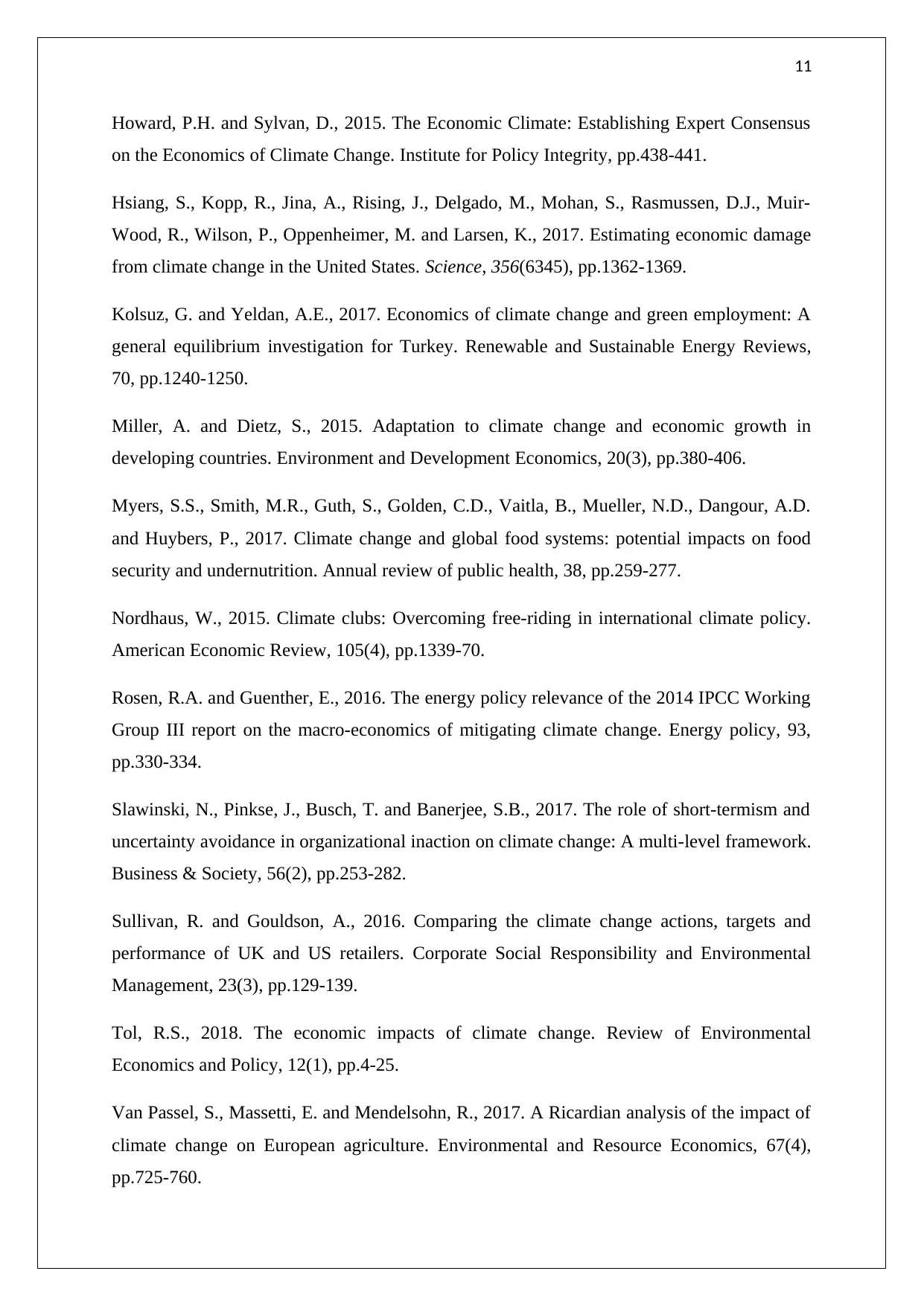
11
Howard, P.H. and Sylvan, D., 2015. The Economic Climate: Establishing Expert Consensus
on the Economics of Climate Change. Institute for Policy Integrity, pp.438-441.
Hsiang, S., Kopp, R., Jina, A., Rising, J., Delgado, M., Mohan, S., Rasmussen, D.J., Muir-
Wood, R., Wilson, P., Oppenheimer, M. and Larsen, K., 2017. Estimating economic damage
from climate change in the United States. Science, 356(6345), pp.1362-1369.
Kolsuz, G. and Yeldan, A.E., 2017. Economics of climate change and green employment: A
general equilibrium investigation for Turkey. Renewable and Sustainable Energy Reviews,
70, pp.1240-1250.
Miller, A. and Dietz, S., 2015. Adaptation to climate change and economic growth in
developing countries. Environment and Development Economics, 20(3), pp.380-406.
Myers, S.S., Smith, M.R., Guth, S., Golden, C.D., Vaitla, B., Mueller, N.D., Dangour, A.D.
and Huybers, P., 2017. Climate change and global food systems: potential impacts on food
security and undernutrition. Annual review of public health, 38, pp.259-277.
Nordhaus, W., 2015. Climate clubs: Overcoming free-riding in international climate policy.
American Economic Review, 105(4), pp.1339-70.
Rosen, R.A. and Guenther, E., 2016. The energy policy relevance of the 2014 IPCC Working
Group III report on the macro-economics of mitigating climate change. Energy policy, 93,
pp.330-334.
Slawinski, N., Pinkse, J., Busch, T. and Banerjee, S.B., 2017. The role of short-termism and
uncertainty avoidance in organizational inaction on climate change: A multi-level framework.
Business & Society, 56(2), pp.253-282.
Sullivan, R. and Gouldson, A., 2016. Comparing the climate change actions, targets and
performance of UK and US retailers. Corporate Social Responsibility and Environmental
Management, 23(3), pp.129-139.
Tol, R.S., 2018. The economic impacts of climate change. Review of Environmental
Economics and Policy, 12(1), pp.4-25.
Van Passel, S., Massetti, E. and Mendelsohn, R., 2017. A Ricardian analysis of the impact of
climate change on European agriculture. Environmental and Resource Economics, 67(4),
pp.725-760.
Howard, P.H. and Sylvan, D., 2015. The Economic Climate: Establishing Expert Consensus
on the Economics of Climate Change. Institute for Policy Integrity, pp.438-441.
Hsiang, S., Kopp, R., Jina, A., Rising, J., Delgado, M., Mohan, S., Rasmussen, D.J., Muir-
Wood, R., Wilson, P., Oppenheimer, M. and Larsen, K., 2017. Estimating economic damage
from climate change in the United States. Science, 356(6345), pp.1362-1369.
Kolsuz, G. and Yeldan, A.E., 2017. Economics of climate change and green employment: A
general equilibrium investigation for Turkey. Renewable and Sustainable Energy Reviews,
70, pp.1240-1250.
Miller, A. and Dietz, S., 2015. Adaptation to climate change and economic growth in
developing countries. Environment and Development Economics, 20(3), pp.380-406.
Myers, S.S., Smith, M.R., Guth, S., Golden, C.D., Vaitla, B., Mueller, N.D., Dangour, A.D.
and Huybers, P., 2017. Climate change and global food systems: potential impacts on food
security and undernutrition. Annual review of public health, 38, pp.259-277.
Nordhaus, W., 2015. Climate clubs: Overcoming free-riding in international climate policy.
American Economic Review, 105(4), pp.1339-70.
Rosen, R.A. and Guenther, E., 2016. The energy policy relevance of the 2014 IPCC Working
Group III report on the macro-economics of mitigating climate change. Energy policy, 93,
pp.330-334.
Slawinski, N., Pinkse, J., Busch, T. and Banerjee, S.B., 2017. The role of short-termism and
uncertainty avoidance in organizational inaction on climate change: A multi-level framework.
Business & Society, 56(2), pp.253-282.
Sullivan, R. and Gouldson, A., 2016. Comparing the climate change actions, targets and
performance of UK and US retailers. Corporate Social Responsibility and Environmental
Management, 23(3), pp.129-139.
Tol, R.S., 2018. The economic impacts of climate change. Review of Environmental
Economics and Policy, 12(1), pp.4-25.
Van Passel, S., Massetti, E. and Mendelsohn, R., 2017. A Ricardian analysis of the impact of
climate change on European agriculture. Environmental and Resource Economics, 67(4),
pp.725-760.

12
1 out of 12
Related Documents
Your All-in-One AI-Powered Toolkit for Academic Success.
+13062052269
info@desklib.com
Available 24*7 on WhatsApp / Email
![[object Object]](/_next/static/media/star-bottom.7253800d.svg)
Unlock your academic potential
© 2024 | Zucol Services PVT LTD | All rights reserved.




